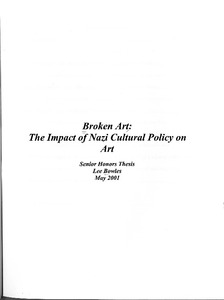| dc.rights.license | In Copyright | en_US |
| dc.creator | Bowles, Lee Alexander | |
| dc.date.accessioned | 2023-04-21T19:30:17Z | |
| dc.date.available | 2023-04-21T19:30:17Z | |
| dc.date.created | 2001 | |
| dc.identifier | WLURG038_Bowles_thesis_2001 | |
| dc.identifier.uri | https://dspace.wlu.edu/handle/11021/36156 | |
| dc.description.abstract | Every element of the Nazi Third Reich focused on collective strategy and conformity. Hitler reorganized the military, the government, and culture itself to create his new vision of a unified Germanic people. . . . As a man already interested in art, Hitler was quick to apply his policies to the visual arts. He believed that art contributed to culture by virtue of its role as part of a collective whole. Hitler saw art as a means of legitimizing the German people in
European and world history. Dr. Joseph Goebbels helped him substantiate the ideology. . . . This synthesis of cultural and political institutions had far reaching effects. The cultural institutions oversaw the planning and the content of exhibitions that defined the difference between "accepted art", the art that conformed to the Nazi image ofNordicism, and "degenerate art", which was modem, avant-garde and tinged with unacceptable racial and political associations. Artists who failed to conform were banned from exhibiting their work. Degenerate artworks were confiscated from German museums and were sold or burned. . . . The importance of individual works as contributions to a greater collection is a tenet present through every level of the Nazi cultural system. The power of art and the fear of individual expression is a continued theme. All of this offers a fascinating opportunity to look at the power of visual images in politics and the power of politics over the perception and acceptance of art. [From Introduction] | en_US |
| dc.format.extent | 86 pages | en_US |
| dc.language.iso | en_US | en_US |
| dc.rights | This material is made available for use in research, teaching, and private study, pursuant to U.S. Copyright law. The user assumes full responsibility for any use of the materials, including but not limited to, infringement of copyright and publication rights of reproduced materials. Any materials used should be fully credited with the source. | en_US |
| dc.rights.uri | http://rightsstatements.org/vocab/InC/1.0/ | en_US |
| dc.subject.other | Washington and Lee University -- Honors in Art History | en_US |
| dc.title | Broken Art: The Impact of Nazi Cultural Policy on Art | |
| dc.type | Text | en_US |
| dcterms.isPartOf | WLURG38 - Student Papers | |
| dc.rights.holder | Bowles, Lee Alexander | |
| dc.subject.fast | National socialism and art | en_US |
| dc.subject.fast | Art and state | en_US |
| dc.subject.fast | Germany | en_US |
| dc.subject.fast | Art, German | en_US |
| local.department | Art History | en_US |
| local.scholarshiptype | Honors Thesis | en_US |
